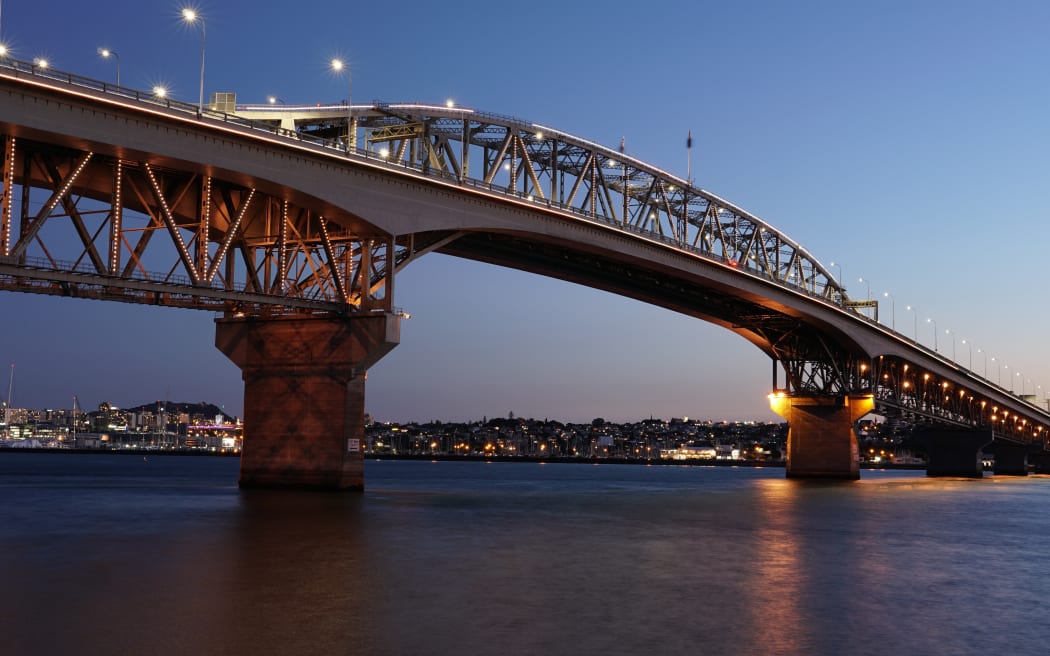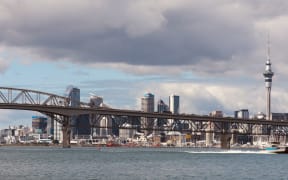
An OIA release shows a wobble that is triggered when enough people walk on Auckland Harbour Bridge has been on the transport agency's radar for at least 13 years. Photo: Unsplash / Daniel Wang
A cycling lobby group is questioning why the transport agency has not already done the work required to take the wobble out of Auckland Harbour Bridge.
Official Information Act (OIA) documents show the bridge's clip-on lanes sway back and forth by 50mm when thousands of people walk on it - but that 13 years ago engineers laid out to Waka Kotahi a low-to-modest cost fix for that.
Bike Auckland spokesperson Fiáin d'Leafy said a lane devoted to walking and cycling would not ever have enough people walking on it to set off the swaying - and cycling does not do it - but the fix should be put in place anyway, just in case any lane set aside was used by marchers or protests.
"I would love to know why they didn't go further and why they haven't simply put them in to make sure that it's safe when people have those marches over the bridge or when they hold their events," they said.
Land hikoi in 1975 and 2004 set off the swaying - which was studied by UK researchers but little reported on here at the time - as did an anti-mandate march last year.
Waka Kotahi said public safety was its top priority on the bridge.
It had organised a three-day event for March when 20,000 people a day would have walked and biked over the bridge. The agency said the numbers on each span would have been carefully controlled.
OIA documents released to Bike Auckland for its study into a walk-bike lane, show "dense crowds of people numbering as low as 250" per span - there are seven spans - can set off the "lateral vibrations", which is worst at spans one, three and four.
Cycling and running do not set it off.
A 2010 investigation for NZTA recommended two damping options, including using shallow tanks of liquid that "slosh under large excitation to dissipate energy". The damping has to be "tuned" to the right frequency.
Bike Auckland had contracted engineer Richard Young, who looked into an assertion Waka Kotahi made to the group in March, in debate over the bike-walk lane.
"The OIA was triggered after Bike Auckland were told by a very senior WK executive (CEO) that the AHB needed strengthening before it could be used for pedestrians and cycling as it swayed," Young told RNZ in a statement.
"A small gap between the clip-on lanes and the original bridge rapidly opens and closes by 50mm, which would crush anything placed into it. It appears that NZTA have been aware of this issue for many years and have a relatively simple fix."
Young asked for more information from the agency, noting the bridge was significantly strengthened in recent years.
The OIA release now shows, for the first time, that this has been on the agency's radar for at least 13 years.
"The WK concerns about clip-on wobble appear to be genuine but easily solvable and not relevant to the single shared path option proposed by Bike Auckland," Young said.
D'Leafy said cyclists and walkers did not want to wait 10-plus years for a second harbour crossing to be built.
The group was now seeking a meeting with Waka Kotahi.
"So we've gone through the issues that they've raised ... and we've come back with a solution."
D'Leafy did know the costings for the dampers.
"The bridge is 64 years old. It was supposed to have walking and cycling on it, originally, and it didn't. It's been a problem ever since it as built, and 66 percent of Aucklanders say that they would walk and cycle across it."
RNZ has asked Waka Kotahi for the costings, and why it did not proceed with the work.



